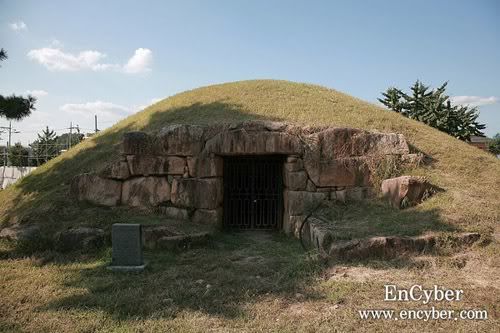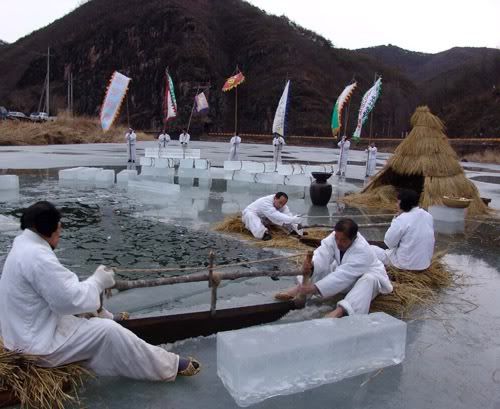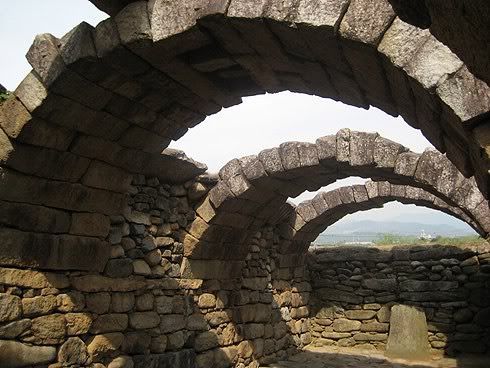Ice Houses (석빙고) in Joseon Korea
We're halfway through 초복, the first stage of the summer 'dog days' in Korea, and while looking through articles earlier today I came across something that bridges the division between that and my entry on the addition of forty Joseon royal tombs to the list of UNESCO World Heritage Sites. Funny how that worked out. Digging around a little bit online in relation to the royal tombs brought up a couple of websites that list some of the rituals performed in association with constructing a tomb for a recently-deceased member of the royal family and, in particular, the Spring 2009 edition of Koreana magazine features an article on burial practices during the Joseon Dynasty that includes this description:
After a king’s death, the body would be clothed in formal garments of white silk, which was followed by an additional dressing on the third day, and a final dressing on the fifth day. Thereafter, the body was placed into a coffin, and a coronation ceremony was conducted to install the new king. As a reflection of its status-based society, the length of pre-burial mourning for Joseon rulers and court officials was determined by applicable protocol. For kings and queens, there would be a five-month period from the time of passing until the final burial.
However, it was essential to properly preserve the body prior to its burial, which called for the implementation of special measures, especially during the summer months. Fortunately, for Korea, which had acquired the technology for storing ice from the time of the ancient Three Kingdoms period, it maintained two icehouses in Seoul: Dongbinggo (eastern) and Seobinggo (western).

창녕석빙고 from EnCyber
I don't have the exact location for either Dongbinggo (東氷庫; 동빙고) or Seobinggo (西氷庫; 서빙고), but both are located in the Yongsan district of Seoul and have local neighborhoods named after them. Dongbinggo is the larger of the two and supplied ice to court officials and the royal kitchen while the use of Seobinggo was restricted to formal rituals in honor of the royal family. King Taejo, founder of the Joseon Dynasty (r. 1392-1398), is responsible for ordering their construction.
According to Yun Yong Hyeon (윤용현) of the Chung Cheong Daily News (충청일보), Seobinggo was built during the fourth year of Taejo's reign at the base of Dunjisan (屯智山 - either the name of a mountain or a reference to a Joseon army fort) near the Han River while Dongbinggo was constructed at Dumopo (豆毛浦), though I'm not entirely sure how to translate the Hanja in that name. For those of you keeping track at home, this entry from Nate Encyclopedia explains that Dumopo is located in present day Oksu-dong in Seongdong-gu, Seoul.
That same Nate entry also mentions how the site of Seobinggo was moved south in the year 1504 - during the reign of King Yeonsangun - and its use was discontinued in the year 1898. Other ice houses - seokbinggo - were built across the country, with nine currently known. Apart from the two in Seoul there are also sites in the cities of Changnyeong (310호), Cheongdo (323호), Hyeonpung (673호), Yeongsan (169호), Andong (305호), and Gyeongju (66호) in South Korea, plus Haeju (69호) in North Korea. Numbers in parentheses indicate the Cultural Heritage Administration's designation of when each site become a Treasure of Korea. Clicking on a name will take you to a page with photos and more information.

Cutting Ice on the Nakdong River, Andong from 안동시 News Letter
Returning to the Koreana piece and a description of the logistics involved in royal funeral rites,
During the mourning period, the coffin of a king or queen would be placed above an ice tray and enclosed with a framework of bamboo that was packed with ice, which provided adequate refrigeration to preserve the body. Over the five-month period, some 15,000 blocks of ice might be required, which could deplete the entire inventory of stored ice. As such, a ruler’s advancing age or an indication of serious illness necessitated measures to assure a sufficient supply of ice.
Although the ice enabled the body to be preserved, additional provisions were needed to absorb the moisture that resulted from its melting. For this, another bamboo framework was installed that would be packed with dried seaweed, which provided a dehumidifying insulation to absorb the moisture. Over the course of five months, huge mounds of seaweed would be needed for this purpose.
Of note, King Sejo (r. 1455-1468) put an end to a few of the more elaborate funerary rituals through some of the requests made in his will. Among these was a desire that his coffin be made of wood and the inner burial chamber from plaster instead of stone, and the elimination of using flat stones around the base of the tumulus. I haven't caught any mention on whether ice preservation was one of the rituals dropped as part of these streamlining measures, which means it's possible the practice continued until the 1898 abandonment of Seobinggo.

경주 석빙고 from 충청일보
Before you start to wonder if I've forgotten about the connection alluded to at the start of this entry, one of the sub-entries for sambok and the sixth lunar month in my copy of Annual Customs of Korea ties in to the purpose of Seokbinggo:
* Ice Distribution (Eoreum tagagi) ... Until the end of the Yi Dynasty, small blocks or wooden tickets authorizing a certain quantity of ice were issued from the palace to the higher officials and others during the hot summer season. The ice ticket was presented to the ice-store house for the authorized ration of ice.
Eoreum is a romanized form of 여름, the Korean word for summer, but I have no idea what tagagi is supposed to be in Korean. This is why I hate books about Korean culture that only include transliterated terms without the corresponding 한글 (Korean) -- it usually makes looking for more information a much more laborious task. Pardon the mini-rant. Anyway, now you know a little about where these officials were going to get their summer's quota of ice.

청도석빙고 from OhMyNews
.